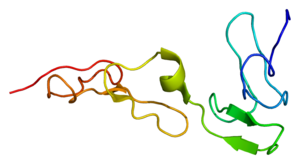Protein S deficiency
| Protein S deficiency | |
|---|---|
 |
|
| Protein S | |
| Classification and external resources | |
| Specialty | hematology |
| ICD-10 | D68.5 |
| ICD-9-CM | 289.81 |
| OMIM | 176880 |
| DiseasesDB | 10814 |
| eMedicine | med/1924 |
| Patient UK | Protein S deficiency |
| MeSH | D018455 |
Protein S deficiency is a disorder associated with increased risk of venous thrombosis.Protein S, a vitamin K-dependent physiological anticoagulant, acts as a nonenzymatic cofactor to activate protein C in the degradation of factor Va and factor VIIIa. Decreased (antigen) levels or impaired function of protein S leads to decreased degradation of factor Va and factor VIIIa and an increased propensity to venous thrombosis. Protein S circulates in human plasma in two forms: approximately 60 percent is bound to complement component C4b β-chain while the remaining 40 percent is free, only free protein S has activated protein C cofactor activity
There are three types of hereditary protein S deficiency:
Among the possible presentation of protein S deficiency are:
In terms of the cause of protein S deficiency it can be in inherited via autosomal dominance.A mutation in the PROS1 gene triggers the condition. The cytogenetic location of the gene in question is chromosome 3, specifically 3q11.1 Protein S deficiency can also be acquired due to vitamin K deficiency, treatment with warfarin, liver disease, and acute thrombosis (antiphospholipid antibodies may also be a cause as well)
In regards to the mechanism of protein S deficiency we should start by indicating that,Protein S is principally made in liver cells. Protein S is a cofactor of APC both work to degrade factor V and factor VIII.It has been suggested that Zn2+ might be necessary for Protein S binding to factor Xa.
...
Wikipedia
